
Pay attention that this page is under construction.
Information inside can be read but shall not be taken as input for any exam or definite information.
¶ Introduction
The concept of weight and balance is critical in aviation industry. Compliance with the known limits is very important relating to the flight safety. Aircraft balance refers to the location of the center of gravity (CG) of an aircraft. Operation with CG outside the approved limits results in control difficulty.
Preflight planning should include a check of performance charts to determine if the aircraft's weight may contribute to hazardous flight operations.
¶ CG Concept
The CG of a body is the theoretical point at which the entire weight of that body is assumed to be concentrated. In a airplane, the CG is a point at which the aircraft would balance if it were suspended atthat point.
The primary concern in balancing an aircraft is the fore and aft location of the CG along the longitudinal axis. The CG is not necessarily a fixed point. Its location depends on the distribution of weight in the aircraft. The distance between the forward and back limits for the position of the center for gravity or CG range is certified for an aircraft by the manufacturer.
On small airplanes and on helicopters, the CG location is identified as being a specific number of inches or millimeters from the datum and the CG range is identified the same way. On larger airplanes, the center of gravity and its range are typically identified in relation to the width of the wing (usually mean aerodynamic chord is used).
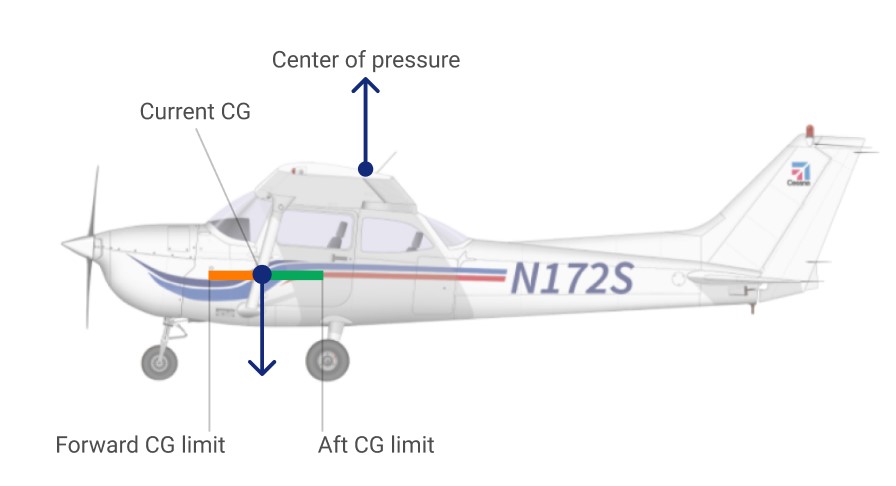
¶ Balancing the aircraft
Each aircraft has a determed and precalculated weight and balance references and numbers. Basically speaking it looks like this:
- Manufacturer defines:
- reference datum - an imaginary vertical plane or line from which all measurements of arm are taken.
- the arms (moment arms) - the horizontal distance in inches from the reference datum line to the CG of an item. The algebraic sign is plus (+) if measured aft of the datum and minus (--) if measured forward of the datum.
- the empty weight and the empty weight centre of gravity.
- All calculated data are published on pilot oparating manual and weight and balance sheet.
The actual location of the CG can be altered by many variable factors and is usually controlled by the pilot:
- Placement of baggage and cargo items determines the CG location.
- The assignment of seats to passengers can also be used as a means of obtaining a favorable balance. If an aircraft is tail heavy, it is logical to place heavy passengers in forward seats.
- Fuel burn can also affect the CG based on the location of the fuel tanks. For example, most small aircraft carry fuel in the wings very near the CG and burning off fuel has little effect on the loaded CG.
¶ Effects of adverse balance
Flying an aircraft that is out of balance can produce increased pilot fatigue with obvious effects on the safety and efficiency of flight. Adverse balance conditions affect flight characteristics in much the same manner as those mentioned for an excess weight condition. Stability and control are also affected by improper balance.
It is vital to comply with weight and balance limits established for all aircraft.
¶ Stability
- Loading in a nose-heavy condition causes problems in controlling and raising the nose, especially during takeoff and landing.
- Loading in a tail heavy condition has a serious effect upon longitudinal stability, and reduces the capability to recover from stalls and spins.
- During landing exceeding the forward CG limit may result in excessive loads on the nosewheel, decreased performance, higher stalling speeds, and higher control forces.
¶ Control
- CG location that is beyond the forward limit may result in nose heaviness, making it difficult or impossible to flare for landing.
- CG location aft of the allowable range may include extreme control difficulty, violent stall characteristics, and very light control forces which make it easy to overstress an aircraft inadvertently.
- A restricted forward CG limit is also specified to assure that sufficient elevator/control deflection is available at minimum airspeed.
¶ Practical example
Let's take a look onto standard Cessna 152 weight and balance sheet and try to calculate weight and CG for different phases of flight.
Conditions:
Pilot weight: 160 lbs
Passenger weight: 140 lbs
Fuel required for flight: 15 gallons
Fuel consumption for flight: 7 gallons Baggage: 50 lbs.
Usually weight and balance sheet for general aviation consists of 2 parts: data table and CG graph (envelope). Our first step is to fill the table with actual data.
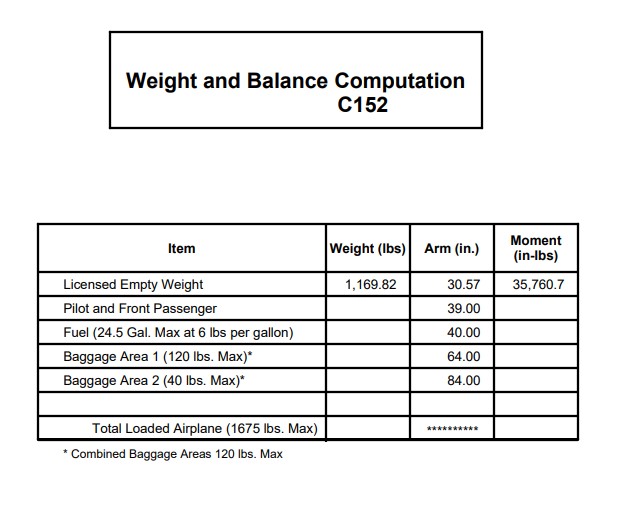
1. Fill the table with weight data.
Use the conditions from above to fill the table and calculate total weight.
- Remember, that gallon is a volume value, not weight. To get fuel mass, multiple volume by 6 (standard 100LL fuel weight per 1 gallon).
- As far as we have a limit of 40 lbs in the baggare area 2, the only option is to put baggage into area 1.
- Make sure total weight is lower then maximum certified weight (1675 lbs in this case).
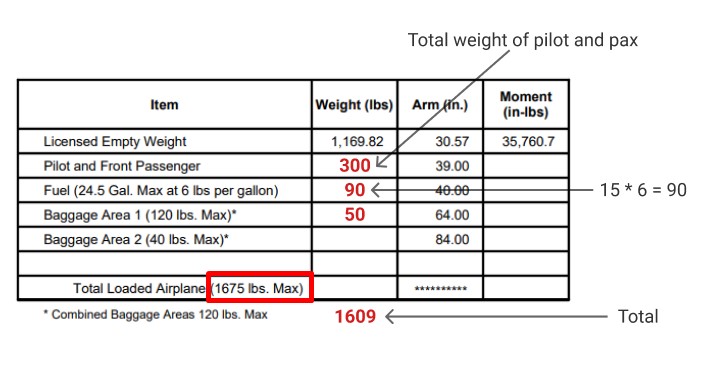
2. Calculate the moments.
* Multiply each weight that was entered by its corresponding arm from the "Arm" column and put the result in the "Moment" column.
- Devide total moment by total weight to get current CG.
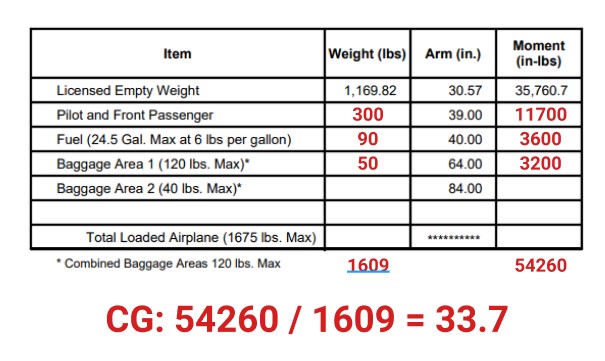
3. Verify the numbers.
Verify that the total weight and CG for takeoff fall within the envelope.
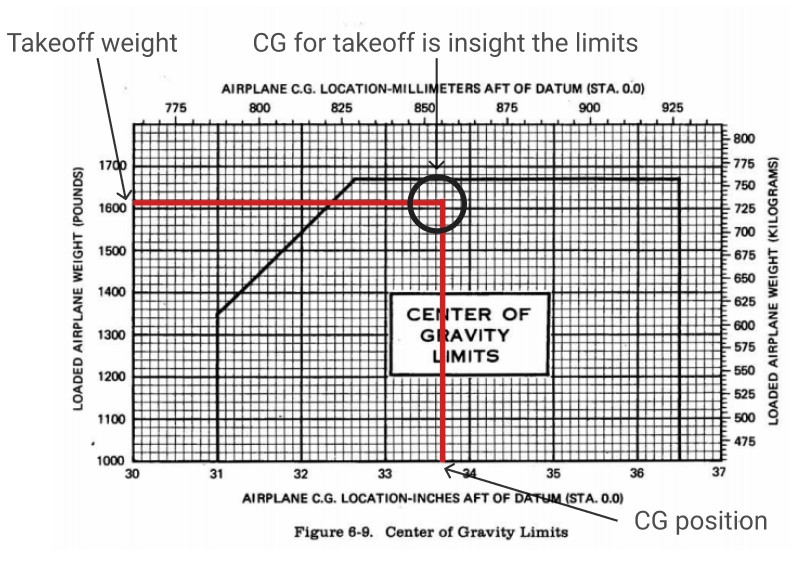
4. Check weight and CG for landing.
During flight, fuel burn is normally the only weight change that takes place. As fuel is used, an aircraft becomes lighter. Furthermore, fuel moment also changes and it for sure affects total moment and CG position.
- Fuel weight at destionation will be 8 * 6 = 48 lbs.
- Resulted moment will be 48 * 40 = 1920 in-lbs.
- Landing weight will be 1567 lbs, landing total moments is 52580 in-lbs, therefore CG on landing is going to be 33.55. Let's check the envelope.
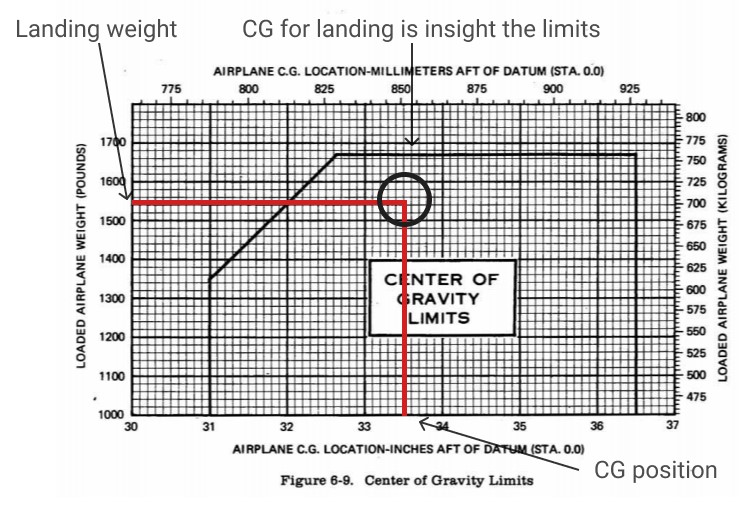
Summary: weight and CG is insight the limits during all phases of flight, nor extremly forward or aft, so the flight could be safely performed.
- FAA Pilot's Handbook of Aeronautical Knowledge
- Skybrary
- VID 531824 - Creation
- VID 496402 - Wiki.js integration